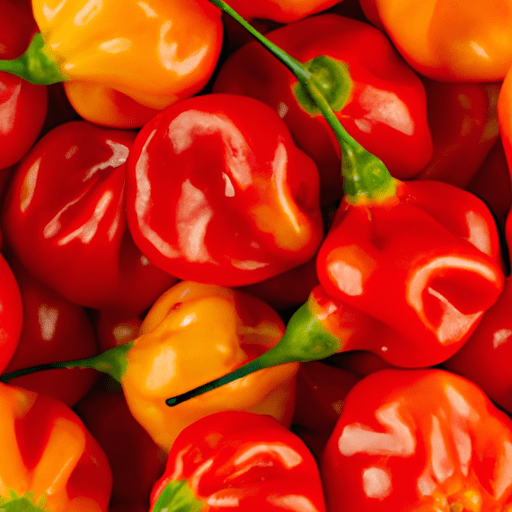The Fiery Gem: Habanero Chile
If you’re someone who seeks excitement and a thrill in your culinary adventures, look no further than the habanero chile. Known for its intense heat and unique flavor profile, this little pepper packs a punch that can awaken even the most seasoned of taste buds.
Taste and Heat
The habanero chile can be described as intensely spicy, yet delightfully fruity. It has a distinctive floral aroma with hints of citrus undertones, making it a favorite among spicy food enthusiasts. The heat of the habanero is known to linger on the palate, leaving a tingling sensation that adds an extra layer of excitement to any dish.
Common Uses in Cooking
Habanero chiles are a staple ingredient in various cuisines, particularly those of the Caribbean, Mexico, and Central America. They bring a vibrant heat and flavor to dishes, enhancing both savory and sweet recipes alike. Here are a few common ways they are used:
Salsas and Hot Sauces: Habaneros add a fiery kick to salsas, making them the star of the show. Their vibrant color and intense heat can transform a dull dip into a flavor explosion.
Marinades and Rubs: When incorporated into marinades and rubs, the habanero imparts its spiciness while infusing a wonderful depth of flavor into meats, seafood, or even vegetables.
Stews and Curries: Habaneros make a powerful addition to hearty stews and curries, elevating the overall taste profile with their complex heat and fruity undertones.
Fruit-based Dishes: Surprisingly, habanero chiles can be used in sweet applications too! They can add a subtle yet tantalizing heat to fruit salsas, jams, and desserts like chocolate or fruit-based tarts.
Nutritional Value
Aside from their flavor, habanero chiles offer various nutritional benefits. Packed with vitamins, minerals, and antioxidants, they can contribute positively to your overall health. Here are some key elements found in habaneros:
Vitamin C: Habanero chiles are an excellent source of vitamin C, providing a significant boost to your immune system and promoting collagen synthesis.
Capsaicin: The compound responsible for the heat in habaneros, capsaicin, has been found to have several health benefits. It may help reduce inflammation, boost metabolism, and even act as a natural pain reliever.
Vitamins A and E: Habaneros are rich in vitamins A and E, both of which are powerful antioxidants that protect your cells from damage caused by free radicals.
Interesting Facts and History
Habanero chiles have a fascinating history that dates back centuries. Here are some intriguing facts:
Name Origins: The term “habanero” is believed to derive from the Spanish word “Habana,” meaning Havana. This refers to the peppers’ popularity in Cuba and the Caribbean.
Scoville Scale: Habaneros are known for their high Scoville heat units (SHU). Ranging from 100,000 to 350,000 SHU, they’re among the hottest chiles in the world. To put it into perspective, they are up to 140 times hotter than a jalapeño!
Globally Loved: Habanero chiles have gained immense popularity worldwide due to their unique flavor and heat. They have become a favorite among spicy food enthusiasts and are frequently showcased in international culinary competitions.
So, whether you crave the fiery thrill or want to explore the vibrant flavor, the habanero chile is certain to add excitement to your cooking endeavors. Just remember to handle them with care and moderation, as their heat can be quite intense. Embrace the adventure and let the habanero take your taste buds on a journey they won’t soon forget!
Note: When using habanero chiles in your recipes, make sure to wear gloves and avoid touching your face or eyes. The capsaicin in the chiles can cause irritation.
Sure! Here are some interesting facts about habanero chile:
Origin: The habanero chile (Capsicum chinense) is native to the Yucatan Peninsula in Mexico, where it has been cultivated for centuries. It gets its name from Havana, the capital city of Cuba, suggesting its introduction to other parts of the world through trade routes.
Heat Level: The habanero is one of the hottest chili peppers in the world. It typically ranges from 100,000 to 350,000 Scoville Heat Units (SHU), but some strains can reach up to 1 million SHU. For comparison, a jalapeno pepper ranges from 2,500 to 8,000 SHU.
Flavor Profile: Despite its intense heat, the habanero also has a distinct fruity aroma and flavor, often described as citrusy, sweet, and floral. This unique combination of heat and flavor makes it a popular ingredient in many cuisines.
Common Uses: Habanero chiles are commonly used in Caribbean, Mexican, and Central American dishes. They can be used in salsas, hot sauces, marinades, and rubs to add both heat and flavor to dishes like jerk chicken, salsa verde, and spicy curries.
Nutritional Benefits: Habanero peppers are low in calories and rich in vitamins like vitamin C, vitamin A, and B vitamins. They also contain capsaicin, a compound known to have anti-inflammatory and pain-relieving properties.
Historical Significance: Habaneros have a long-standing culinary and cultural significance in the regions where they are grown. In Mexican cuisine, for example, the habanero is considered an essential ingredient and is often used to add heat and flavor to traditional dishes.
Unique Properties: Apart from being spicy and flavorful, the habanero pepper has another interesting property. The capsaicin in habaneros can stimulate the release of endorphins, which are natural painkillers in the human body. This is why some people experience a pleasurable and euphoric sensation after consuming spicy foods like habaneros.
Remember to use caution when handling habanero chiles, as their oils can cause skin and eye irritation. It’s always a good idea to use gloves and wash your hands thoroughly after handling them.




Use the share button below if you liked it.
It makes me smile, when I see it.